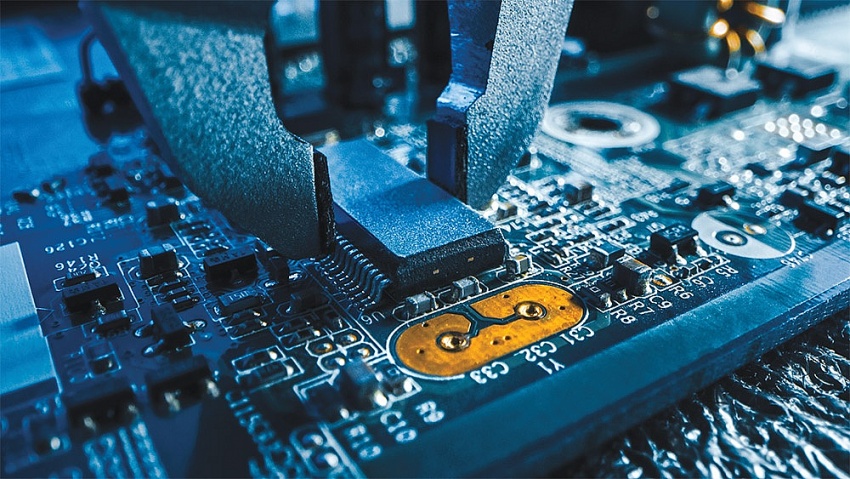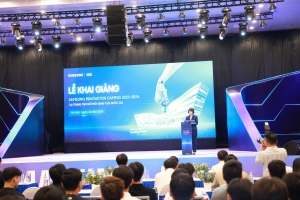Global race for chip engineers heats up
 |
| Global race for chip engineers heats up |
At last week’s conference on the issue, Prime Minister Pham Minh Chinh declared that the country must consider training and developing such resources as the key breakthrough for progress. “Human resource supply is one of the factors that partners and investors highly appreciate in Vietnam. If preparing well, we will receive the trust of partners, promote investment attraction, and develop the semiconductor production and supply chain,” he said.
Marc Woo, managing director of Google Vietnam and Asia-Pacific, said to do this, infrastructural development is one of the priority factors.
“Investing in infrastructure is essential to promote the development of semiconductors and AI in Vietnam. Access is needed for cloud computing, and promoting reliable cross-border data flows will also ensure the sharing of data, information, and expertise needed to nurture Vietnam’s intellectual talent,” Woo said.
Besides that, a plan to enhance strong AI skills is also needed. “AI is one of the priority areas of innovation in the technology sector. An AI-powered economy requires an AI-savvy workforce,” he added.
Vietnam has already established the National Innovation Centre (NIC) at Hoa Lac High-tech Park in Hanoi and other IT hubs. There are 240 universities in the country, 160 of which have specialised technical training, and could convert to train semiconductor human resources. And 35 other facilities are training in fields related to the semiconductor industry.
Vu Hai Quan, chancellor of Vietnam National University (VNU) in Ho Chi Minh City, emphasised the need for shared labs. “It is straightforward to only prioritise microchip technology, but this could be an interdisciplinary stem lab for all physics, chemistry, materials technology, electronics, telecommunications, microchips, and semiconductors. It will serve not only semiconductor training but all other related field engineers,” Quan suggested.
Pham Bao Son, vice rector of VNU Hanoi, highlighted the role of equipment and laboratories. “We also proposed a project of building an integrated circuit design, manufacturing, and testing centre at VNU Hanoi, serving all the stages of the semiconductor industry. The proposal has already been sent to the Ministry of Planning and Investment,” Son said.
Tran Hung, founder and CEO of Got It - an AI-based education developer established in 2011 - highly appreciated the NIC for building the Vietnam Innovation Network and gathering Vietnamese talent from overseas. “In the short-term strategy, if there are numerous engineers who can start work within the next 24 months, we must immediately call them,” Hung said.
“Practical on-the-job training is important. Contacting this network, we can build the one-on-one programme so that Vietnamese experts abroad can really help students in Vietnam transiting into this industry,” he suggested. “In a long-term plan, we should build training programmes for students from primary and secondary schools. We must have good students from an early age, and training for a long time to become high-quality engineers.”
Minister of Planning and Investment Nguyen Chi Dung said the global chip race is heating up and Vietnam has a favourable opportunity to become one of the countries participating in the semiconductor industry value chain. More than one million employees worldwide by 2030 are needed for all stages of chip manufacturing. “Vietnam has a once-in-a-lifetime opportunity to participate in the global semiconductor industry value chain,” Minister Dung said.
| Tech-industrial company Phenikaa Group participates in the semiconductor industry in Vietnam with strategic investments: It established Phenikaa Semiconductor Training Centre at Phenikaa University in Hanoi in April with the aim of training high-quality human resources. It will also launch a spin-off company in integrated circuit (IC) design and manufacturing, while Phenikaa University will introduce an IC design major into its formal training programme in 2024-2025. With the most modern equipment, the centre will conduct research and training activities in IC design, semiconductors, and tech transfer, and will cooperate with domestic and foreign partners to promote research and training activities. The centre has set a goal of training more than 8,000 IC design engineers with international certificates and training at least 12,000 engineers and high-level workers with international certification to work in factories by 2030. |
| Call to arms for semiconductor roles Chip design is set to boom in Vietnam in the coming years, with many investors entering the market. However, human resource training needs more backing for the industry to achieve high quality and capture opportunities. |
| Vietnam to become key link in semiconductor value chain The Vietnamese government provided positivity and expectation for the country to develop its semiconductor industry at a pivotal conference on April 24 focusing on human resource development. |
 | Samsung and NIC to train 200 students Samsung and the National Innovation Centre (NIC) kicked off the Samsung Innovation Campus (SIC) in Hoa Lac Hi-tech Park on May 3, with six training courses for 200 students. |
| Semiconductor success in reach with investment During the InnovaConnect event organised in April, Lee Young Hee, director of the Center for Integrated Nanostructure Physics at the Institute for Basic Sciences at Sungkyunkwan University, and Park Inkyu, head professor at the Department of Mechanical Engineering at the Korea Advanced Institute of Science and Technology, shared their insights with VIR’s Hoang Minh about Vietnam’s advantages in developing the semiconductor industry, as well as trends in the industry that the nation should pursue. |
What the stars mean:
★ Poor ★ ★ Promising ★★★ Good ★★★★ Very good ★★★★★ Exceptional
Related Contents
Latest News
More News
- Kolon signs $48 million airbag supply deal with Autoliv (December 15, 2025 | 18:14)
- National Assembly approves Vinh–Thanh Thuy expressway project (December 15, 2025 | 18:02)
- Quang Tri green-lights $1.59 billion LNG-fired power project (December 15, 2025 | 17:59)
- Stress laid on high-quality FDI inflows (December 15, 2025 | 11:00)
- Can Tho utilises its growth advantages (December 15, 2025 | 09:09)
- Ca Mau unlocking potential to shape a more sustainable future (December 15, 2025 | 09:02)
- Major projects to be inaugurated nationwide (December 15, 2025 | 08:00)
- MoF workshop highlights mounting concerns over ODA on-lending costs (December 12, 2025 | 16:05)
- National Assembly approves pilot mechanisms to accelerate major projects in Hanoi (December 12, 2025 | 11:29)
- Legislation gives government flexibility for loan guarantees (December 11, 2025 | 18:04)

 Tag:
Tag:





















 Mobile Version
Mobile Version